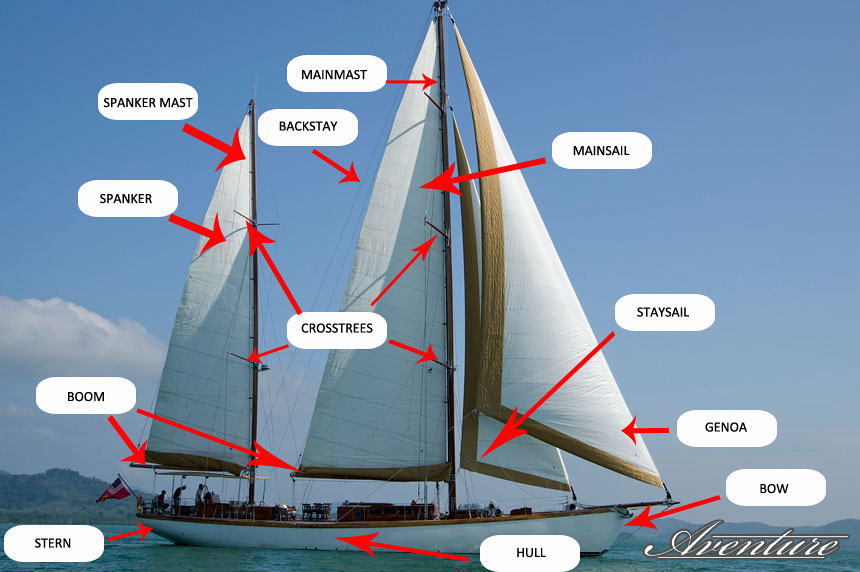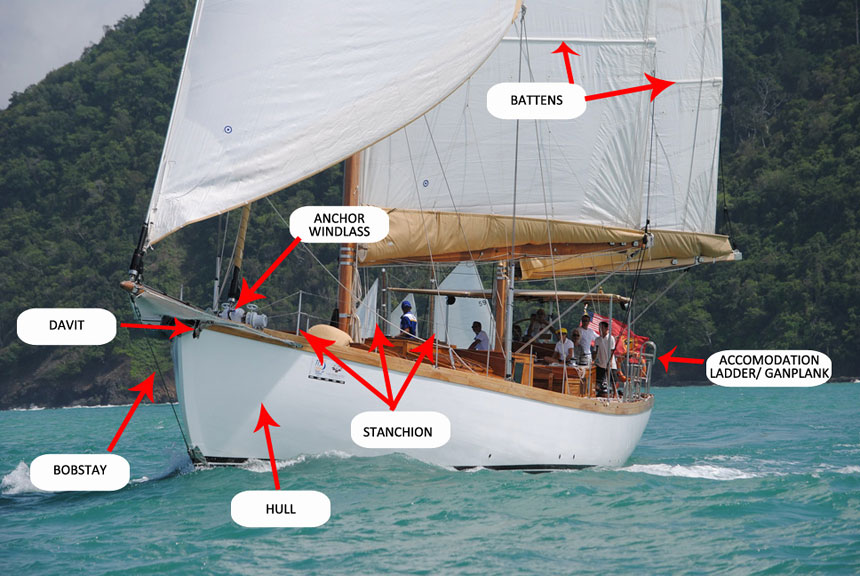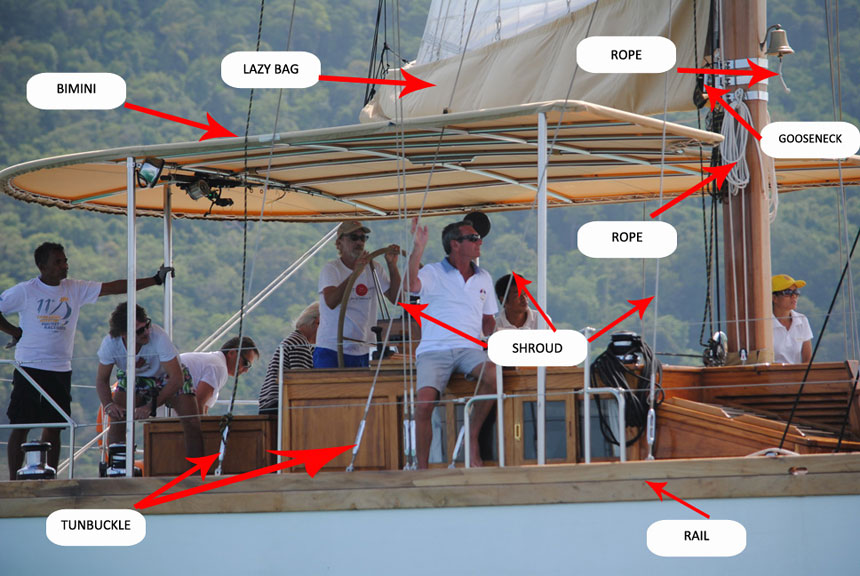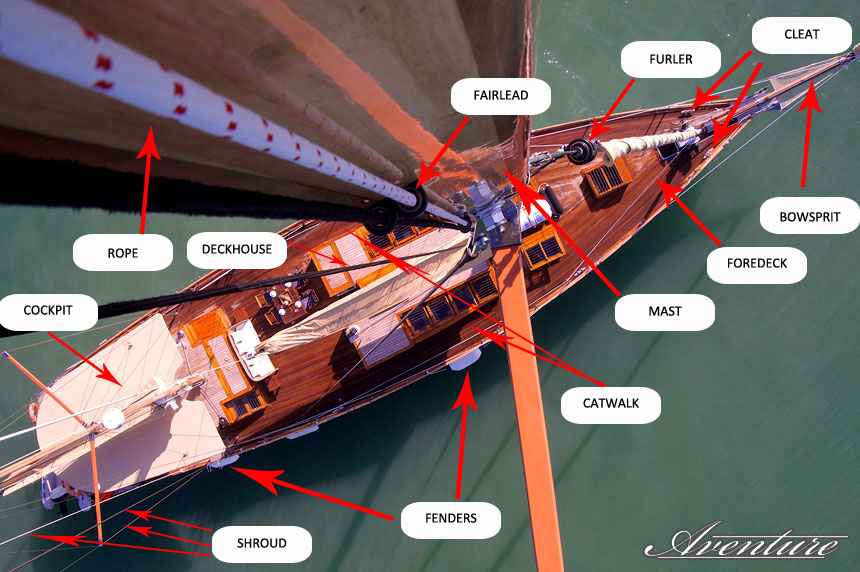![]()

A
- ANCHORAGE: a suitable place for a ship to anchor.
- ANCHOR WINDLASS: a machine that restrains and manipulates the anchor chain and/or rope on a boat, allowing the anchor to be raised and lowered.
- APPENDAGE: an underwater fin such as a centerboard dagger board, t\leeborad or rudder.
- ACCOMODATION LADDER /GANPLANK: a moveable ladder or ramp used for boarding a vessel.
B
- BACKSTAY: long lines or cables, reaching from the stern of the vessel to the mast heads, used to support the mast.
- BALLAST TANK: a device used on ships and submarines and other submersibles to control buoyancy and stability.
- BATTEN: a stiff strip used to support the roach of a sail, enabling increased sail area.
- BEAR AWAY: to steer (a vessel) away from the wind.
- BEAT: advanced to windward on alternate tacks.
- BEATING: sailing as close as possible towards the wind (perhaps only about 60°) in a zig-zag course to attain an upwind direction to which it is impossible to sail directly.(also tacking)
- BIMINI TOP: Open-front canvas top for the cockpit of a boat, usually supported by a metal frame.
- BOAT-HOOK: a pole with a hook on the end, used to reach into the water to catch buoys or other floating objects.
- BOBSTAY: a wire or chain leading from the end of the bowsprit down to a chainplate at the forefoot, to counteract the upward pressure of the forestay.
- BOOM: a spar attached to the foot of a fore-and-aft sail.
- BOW: the forward part of a ship.
- BOWSPRIT: a spar projecting from the bow used as an anchor for the forestay and other rigging.
- BROAD REACH: sailing with the wind abaft the beam.
- BULWARK: the extension of the ship's side above the level of the weather deck.
- BUOY: an anchored float used for marking a position on the water or a hazard or a shoal and for mooring.
C
- CABIN: an enclosed room on a deck or flat.
- CATWALK: flow area of both sides of the deckhouse.
- CENTERBOARD: a heavy retractable fin extending through the bottom of a small sailboat to provide stability, reduce leeway and improve the efficiency of the sail. A movable keel.
- CHAIN LOCKER: a forward compartment below deck where the anchor chain is stowed.
- CLEAT: a deck fitting of metal or wood, having opposing horns around which a line is secured.
- COASTAL NAVIGATION: maritime navigation, which is to move from port to port by staying close to the shore.
- COCKPIT: the area towards the stern of a decked vessel that houses the rudder controls.
- COIL: to prepare a line for stowing by turning it in equal loops so that it is neat and orderly and ready for use.
- COMPASS: navigational instrument that gives a reference direction (north) on the horizontal plane, allowing the measurement of horizontal angles to this direction. The compass is graduated from 0 ° (north) to 359 ° in the direction of clockwise (retrograde direction).
- CREST: the highest point of ocean waves.
- CROSSTREE: horizontal timbers mounted athwart ships high on the mast against the ends of which the shrouds are led to increase the angle of the shrouds at the masthead.
- CREW: the people who help the helmsperson sail on boat.

D
- DAVIT: roller attached on a boat for spinning of raising the anchor.
- DECK EQUIPMENT: all the equipment used to maneuver a boat (pulleys, winches, ropes,…)
- DECKHOUSE: an enclosed structure built on the ship's upper or main deck, usually the navigating station though the term can refer to any simple superstructure on deck.
- DRAG (to): to lose control of an anchored vessel because of heavy seas, currents, wind or a foul bottom, so that the anchor cannot hold its ground.
- DRAFT: the vertical distance between the waterline and the deepest part of the keel, usually expressed in feet.
- DRIFT: to move with the wind and current, rather than with power, oar or sail.
E/F
- EASE: to slack a line or sail, for example, to “sheet” out.
- EBB TIDE: the period of time during which the tide is falling.
- ENSIGN: the principal flag or banner flown by a ship to indicate her nationality.
- FAIRLEAD: a ring, hook or other device used to keep a line or chain running in the correct direction or to prevent it rubbing or fouling.
- FENDER: an air or foam filled bumper used in boating to keep boats from banging into docks or each other.
- FIRST MATE: the deck officer who is second in command after the captain.
- FOREDECK: the part of the ship’s main deck that lies near the bow.
- FORESTAY: long lines or cables, reaching from the bow of the vessel to the mast heads, used to support the mast.
- FLOODTIDE: la période de temps pendant laquelle la marée monte.
- FOREMAST: the vertical spar stepped nearest the bow.
- FURL: to roll or gather a sail against its mast or spar.
- FURLER: the spool mechanism to furl or reduce one sail.
G/H
- GALLEY: the kitchen of a ship.
- GENNAKER: a large, lightweight sail used for sailing a fore-and-aft rig down or across the wind, intermediate between a Genoa and a spinnaker.
- GENOA: a large jib, strongly overlapping the mainmast.
- GOOSENECK: fitting that attaches the boom to the mast, allowing it to move freely.
- GYBE: to change from one tack to the other away from the wind, with the stern of the vessel turning through the wind.
- HALYARD: a line used to raise the head of any sail.
- HEADLING: the direction the boat is travelling at any given moment.
- HEAVE TO: to heave is to adjust its course and speed to the wind, sea and swell, so as to reduce rolling and pitching.
- HEEL: to lean or tip under the influence of the wind on sails. Heeling is a normal characteristic of any sailing vessel, and is controlled by the ballast and underwater design of the boat.
- HOIST: to lift or pull up a sail by using block and tackle powered either by human muscles or by machine.
- HULL: the actual body of the boat.
J/K
- JIB: a triangular staysail at the front of a ship.
- KEEL: the central structural basis of the hull.
- KETCH: a two-masted fore-and-aft rigged sailboat with the aft mast (the mizzen) mounted (stepped) afore (in front of) the rudder.

L/M/N
- LATCHING: tie a piece with a rope.
- LAZY BAG: allows to pack the mainsail once it slumped, thus protecting from the sun and other elements.
- LEEWARD: from or toward the side of the vessel that is away from the wind.
- LIFELINE: cable stretched horizontally on the stanchions to ensure the safety of the crew.
- LUFF: to turn gradually toward the eye of the wind so that the sails begin to take air on the lee side and shake.
- MAINMAST: the tallest mast on a ship
- MAINSAIL: the principal and largest sail in a sail plan.
- MIZZEN STAYSAIL: sail on a ketch or yawl, usually lightweight, set from, and forward of, the mizzen mast while reaching in light to moderate air.
- MOORING: an arrangement for securing a boat to a mooring buoy or a pier.
- NAUTICAL MILE: a unit of length corresponding approximately to one minute of arc of latitude along any meridian arc. By international agreement it is exactly 1,852 metres (approximately 6,076 feet).
P
- PASSAGEWAY: hallway of a ship.
- PITCH: the rotation of a vessel around a lateral axis as it heads into heavy seas.
- POINT OF SAIL: term used to describe a sailing boat's orientation in relation to the wind direction.
- PORT: the term for the left side of the vessel when facing forward.
- PROW: stem. The bow of a ship.
- PULLEY: a wheel turned by or driving a rope.
R
- RAIL: a sturdy barricade at the outboard edge of the deck to provide security for passengers and crewmembers.
- REACH: to sail with the wind just forward of the beam, on the beam or the quarter.
- REEFING: to shorten a sail in heavy winds by securing the lower portion at its reef points thereby reducing the power of the sail.
- REEFING POINT: short lines sewn into reinforced patches some distance up from the foot of the sail to be used to reduce the area of a sail in heavy weather.
- RIGGING: the system of masts and lines on ships and other sailing vessels.
- ROLLING: alternating transverse motion of the ship (from port to starboard).
- ROPE: lines in the rigging.
- RUDDER: a submerged plane mounted astern for steering a vessel.
- RUDDERHEAD: the upper end of a rudderpost, to which a tiller, quadrant, or yoke is attached.

S
- SEAMANSHIP: the skills and abilities required to efficiently and safely operate a ship.
- SEXTANT: a precision instrument used to measure the elevation of celestial bodies above the horizon as a means of determining the position of the ship.
- SHEET IN: means tender action ( a sheet for example).
- SHEET: a rope used to control the setting of a sail in relation to the direction of the wind.
- SHROUD: a rope or cable serving to hold a mast up from side to side.
- SLIDE: fittings that are arranged in a slot in the mast to which the sail is bent.
- SOUNDER: a device used to make soundings.
- SPAR: a wooden, iron or steel pole used to support various pieces of rigging and sails.
- SPINNAKER (SPINNY): a large very lightweight downwind racing sail.
- SPINNAKER POLE: a spar clipped on to the clew of a spinnaker to set on the weather side of the mast during a downwind leg.
- SPREADER: a spar on a sailboat used to deflect the shrouds to allow them to better support the mast.
- SQUALL LINE: a fast moving cold front carrying heavy sudden winds and rain showers. The squall line often develops during the spring transitions and may carry a characteristic “roll cloud” at the front.
- STANCHION: a vertical post mounted at the edge of the deck to which a rail or cables are attached as a safety measure.
- STAYSAIL: a triangular sail hoisted on a stay with hanks.
- STEERING WHEEL: a wheel that controls steering on a boat.
- STEM: the extension of keel at the forward end of a ship.
- STARBOARD: The right side of a vessel when seen by someone facing the bow.
- STERN: the after part of the boat.
- STORM JIB: a small tough triangular foresail which is bent on only in heavy winds.
T/U
- TACK: a part of a sail, and also an alignment with the wind. Tacking or jibing is the maneuver of turning between starboard and port tack.
- TIDAL: having to do with the vertical movement of the oceans as influenced by the sun and moon.
- TIGHTEN: action to strain a maximum of one rope.
- TONNAGE: a legal term referring to the measurements of a ship of which weight of cargo is only one part.
- TOPPING LIFT: a halyard fitted to set the angle of the boom
- TROUGH: the lowest point of ocean waves between crests.
- TURNBUCKLE: a mechanism with a threaded opening at both ends which connects to a shroud or stay, and by turning closed, draws the ends together and puts tension on the gear.
- UPWIND: toward or in the direction from which the wind is blowing. Located on the weather side of a ship.
W/Y
- WAKE: waves emanating from a vessel as it passes through the water. The track of disturbed water left behind a moving ship.
- WATCH: a period of time during which a part of the crew is on duty.
- WINCH: a mechanism which employs sets of gears to turn a drum and provide a substantial mechanical advantage for taking a strain on lines. A few turns of the line are taken on the drum to achieve a purchase, and then the winch is turned to bring the line taut. The bitter end of the line can then be secured to a cleat or bollard.
- WEATHER-HELM: the tendency of a sailing vessel to turn up into the wind.
- WETTED AREA: in sail boating, portion of the hull immersed in water.
- YARD: unit of measurement
![]()
![]()
| Tweet | S/Y Aventure |  |
 |
![]()


